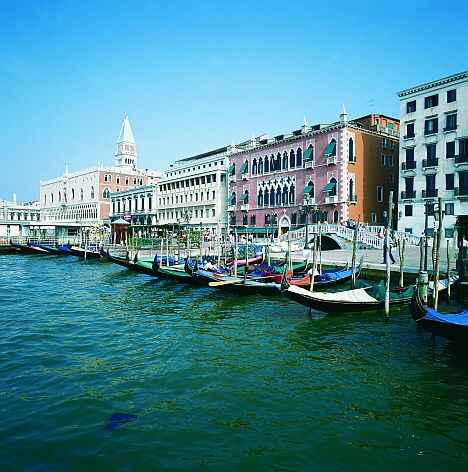
History, photos, design, review of the luxury Hotel Danieli in Venice, Italy.
A long and outstanding history
The hotel to many just known as the Danieli has a long and outstanding history. The building of the Venetian luxury hotel Danieli dates back to the late 14th century when the Dandolo family raised a palace in calle delle Rasse overlooking the Riva degli Schiavoni. At the time, the noble Dandolo family had already given four Dogi – for life elected chief magistrates – to the Most Serene Republic of Venice: Enrico in 1192, Giovanni in 1280, Francesco in 1329 and Andrea in 1343.
In 1498, for the first time in a historic document, the Palazzo Dandolo was mentioned as a place for prestigious travelers to stay when the prince of Salerno, Antonello da Sanseverino, together with his retinue of 44 people stayed at the palace. They entered the building from calle delle Rasse as Riva degli Schiavoni was too narrow to build an entrance at that time.
Over the centuries, numerous famous travelers honored the palace with their presence on the occasion of a trip to Venice, often related to pompous social events. In February 1525, a play was staged at the Palace Dandolo which was attended by the Apostolic Legate in disguise, the Ambassador from Mantua and one of the cousins of the King of England who studied in Padua.
In 1536, Maria, the widow of Andrea Dandolo, split the property with her brothers Pietro and Bernardo Gritti, who took over the first floor, where the French Ambassador used to find accommodation. The rest of the building was split as marriage settlement between Dandolo’s daughters.
In the 17th century, the Palazzo Dandolo changed hands. The new owners, the Mocenigos and the Bernardos, continued the palace’s lavish lifestyle. In 1630, to celebrate the wedding of his daughter Giustiniana (the only child of his first marriage with Elisa de Alvise Pisani) to Lorenzo Giustinian, Girolamo Mocenigo commissioned an opera from Claudio Monteverdi. The libretto for the piece entitled Proserpina rapita was written by Giulio Strozzi. Girolamo Scolari, was in charge of the dancers, Giuseppe Schioppi, one of the finest designers of the day, brought the scenery and stage machines to life. Monteverdi’s music is lost, with the exception of a posthumously published trio, but the libretto with the dedication dated April 16, 1630 survived and was even re-issued in 1644 when Francesco Sacrati wrote a new opera around it for the Teatro San Moisé. The elite of the Venetian aristocracy attended the representation. La Proserpina rapita was staged in the palace’s apartment destined to the couple.
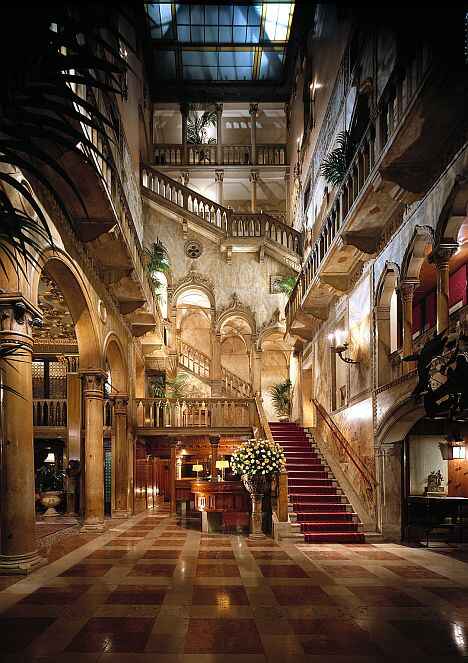
View of the hotel lobby with its dramatic staircase.
Incidentally, in 1613, Claudio Monteverdi had moved to Venice where the Procuratori della Serenissima Repubblica Veneta appointed him as „master of the chapel“ in the Basilica San Marco. As mentioned above, among the clients and patrons supporting Monteverdi was Girolamo Mocenigo, the owner of Palazzo Dandolo, together with his son in law, Lorenzo Giustinian. In addition to La Proserpina Rapita, Mocenigo ordered another opera, to be played with „dramatic action“, from Monteverdi called Il Combattimento di Tancredi. The operatic scena for three voices was staged at the palace between 1624 and 1625 and contains one of the earliest uses of pizzicato in classical music.
In 1797, when the Venetian Republic was conquered by Napoleon Bonaparte and lost its independence after 1070 years, the Bernardo and the Mocenigo families still owned the Palazzo Dandolo.
A major change came on October 24, 1822: the hotelier Giuseppe Dal Niel from Friuli, nicknamed „Danieli“, who already managed the „Leon Bianco“, rented the second floor of the Palazzo Dandolo from Elena Michiel, the widow of Alvise Bernardo. As early as on February 25, 1824 the able businessman managed to purchase it.
Dal Niel aka Danieli restored the palace to its former glory. The annals show that in one year he spent 100.000 Austrian liras to bring the glamour back to the building. In 1840, his adopted daughter, Alfonsina Clement, bought the first floor from the Mocenigo family. Incidentally, Dal Niel named his hotel Le Royal Danieli because „Danieli“ alone sounded not posh enough.
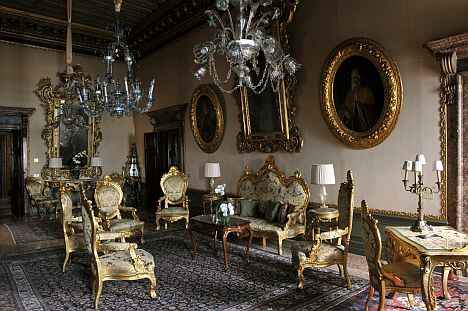
La Suite del Doge. Books about Venice at Amazon US, Amazon UK
.
In 1895, a Mister Genovesi and the Campi Bozzi & C. took over the Hotel Royal Danieli. They new owners renovated the palace and introduced innovations of the time, including elevators, vapor radiators and electric power. Before the turn of the century, they connected the historic Danieli with the palace next door with a bridge between the two first floors. The „new“ building had been raised in 1855. Formerly, it had been used as the headquarters of the Customs offices.
March 17th, 1906 was a major moment in the Italian hotel history: Count Giuseppe Volpi, with the financial help of the Banca Commerciale Italiana, established the Compagnia Italiana Grandi Alberghi (CIGA). The CIGA purchased the Venice Hotel Limited and, therefore, the Hotel Royal Danieli, together with for more hotels in Venice, namely the Grand Hotel, The Roma & Suisse, the Vittoria and the Beau Rivage.
In 1910, important restoration works on the ground floor and on the front of the building led to the disappearance of the last shops ruining the front of the building. In addition, the architect, Francesco Marsich, moved the entrance gate and a window. Two out of three buildings placed between Palazzo Dandolo and Palazzo delle Prigioni were demolished and an outdoor cinema was built above the Caffè Orientale.
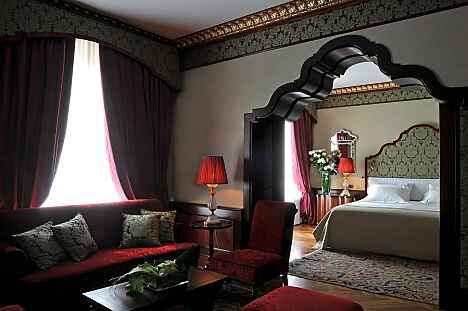
View of a my favorite category: a junior suite at Hotel Danieli.
From today’s hotel terrace you can still enjoy the view of the Ponte dei sospiri, which connects the old prisons to the interrogation rooms in the Doge’s Palace. Since Lord Byron’s writings on the subject, prisoners are said to have given their last sigh crossing the bridge heading towards their execution although, in reality, the Holy Inquisition was no longer active in Venice when The Bridge of Sighs was built. The prison was rather used for small-time crooks. You can however still visit the former Venetian torture chambers.
The Hotel Danieli was last modified in its exterior between 1946 and 1948. Between the Dandolo and delle Prigioni palaces, a new building with a marble front was erected by the architect Virgilio Vallot and named Danielino.
The list of famous guests at the Danieli is endless. Here a few names: Charles Dickens in 1844 and 1853, Richard Wagner in 1858, 1861 and 1880, Truman Capote in 1950. Hundreds of artists, actors and actresses, politicians and otherwise famous people who have stayed at the hotel.
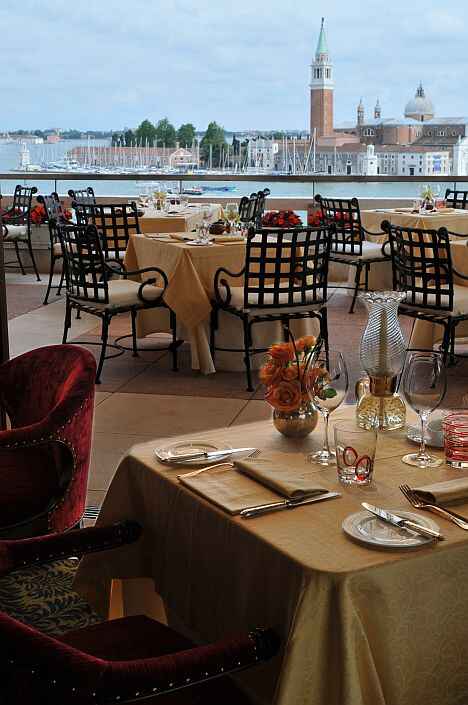
Ristorante Terrazza at the Danieli.
Three famous love stories at the Hotel Danieli in Venice: George Sand and Alfred de Musset
Amantine Aurore Lucile Dupin (1804-1876), later Baroness Dudevant, better known under her pseudonym George Sand, the famous French novelist was notorious for wearing men’s clothing and smoking tobacco in public. In 1831, she left her husband, Baron Casimir Dudevant, and moved to Paris with he two children. Two years later, she met the aristocrat, poet, novelist and leading contributor to the magazine Des Deux Mondes Alfred de Musset (1810-1857). The two lovers decided to travel through Italy. In The Story of My Live, she revealed that they flipped a coin to decide between Rome and Venice. It showed ten times heads for Venice, and she decided that it was fate, traveling to Venice via Florence.
On December 30th, 1833 George Sand and Alfred de Musset arrived by gondola at the Hotel Danieli, at the time called Albergo Reale (Hotel Royal). They took two small rooms next to each other in the mezzanine. Hers – room number 10 – had a small balcony overlooking the Ponte della Paglia.
After one month at the Albergo Reale, Alfred fell seriously ill. Doctor Pietro Pagello was called. By the time the poet had recovered, an overwhelming passion between the young and handsome doctor and George Sand had blossomed. She moved in with the doctor and Alfred had to accept the facts and return alone to Paris. Later the loving couple moved to Paris, where the love story was short lived and the doctor returned to Venice alone. The troubled relationship by George Sand and George de Musset was told in the movie Les enfants du siècle (1999), written and directed by Diane Kurys, staring Juliette Binoche as George Sand, Benoît Magimel as Alfred de Musset and Stefano Dionisi as Pietro Pagello. Masssimo de Rossi plays the manager of the Danieli. The film was shot in the actual hotel rooms Sand and Musset had occupied. Incidentally, Kurys starting point for the film was Musset’s book La confession d’un enfant du siècle.
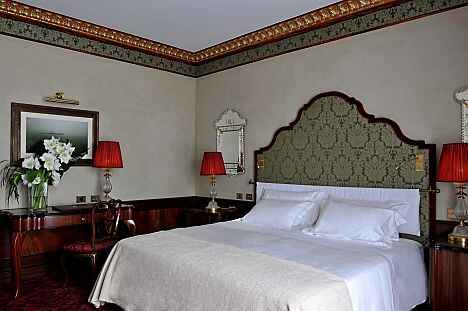
View of a room at Hotel Danieli.
Gabriele d’Annunzio and Eleonora Duse at the Danieli
On September 25, 1895, the actress Eleonora Duse (1858-1924) was at the height of her fame, but had divorced and suffered other disappointments in her love life. It was in Venice that she met for the first time the six years younger poet Gabriele d’Annunzio (1863-1938). She reportedly exclaimed: „I see the sun!“, when she noticed d’Annunzio in front of the Danieli. That very day they spent their first passionate night together in a suite at the Danieli. Despite some breaks, the relation lasted over eight years. They later moved to two villas on the Settignano hill near Florence. She influenced his works, which she played around the world. But in 1904, after emotional and material sacrifices and after being cheated another time, Eleonora Duse left Gabriele d’Annunzio for good in 1904.
The love story between Aristotle Onassis and Maria Callas at the Danieli
The shipping magnate Aristotle Onassis (1906-1975) and the divine soprano Maria Callas (1923-1977) met for the first time during a ball at the Danieli offered by Wally Toscanini Castelbarco, the daughter of the famous Italian conductor on September 3, 1957. He was married to Ahtina Livanos, she to Giambattista Meneghini. Onassis was struck by the singer and tried everything to meet her and her husband again. In July 1959, after several refusals, he managed to invite the couple for a twenty-day cruise on his yacht Cristina, where the soprano fell madly in love with Aristotle. Their love story lasted almost a decade.

View of the Danieli’s restaurant on the top floor.
The present-day Hotel Danieli: interior design by Jacques Garcia
In 2008, the owners of the present-day hotel, the Statuto Group, together with the management, Starwood Hotels & Resorts, have completed an important restoration of the Hotel Danieli. The number of rooms at the Palazzo Danieli Excelsior, which accounts for roughly one third of the total capacity of the Danieli, has been reduced from 81 to 73 to create four brand new corner suites and for junior suites.
At the end of 2008, ten luxury rooms with canal view (camera di lusso rinovata) and a terrace had been renovated, e.g. 351, 352, 353, 354, 355. They are the best deals available. Book them in advance! If you can afford it, go for the new junior suites and suites renovated and redecorated by Jacques Garcia (*1947) in a fresh design. Garcia has been responsible for the redecoration of many luxury hotels, including the Hôtel Costes and L’Hôtel in Paris and La Réserve in Geneva, to name just three. He always respects the tradition, but gives it a fresh touch. His private clients are legion and include the French industrialist billionaire Bouygues as well as the Sultan of Brunei.
At Hotel Danieli, Jacques Garcia married Venetian elements with other timeless touches. The elegant Italian marble bathrooms are equipped with heated mirrors. They guarantee a clear vision even after a hot bath.

Another view of the Danieli’s gorgeous lobby.
Garcia is echoing the Venetian Gothic style, present in the Danieli’s famous hotel hall, in a cleaner style, enhancing the grandeur of the hall. The interior decorator also refurbished the Terrazza Danieli Restaurant with its splendid view of the Venetian lagoon. For more intimacy, the space has been divided into smaller sections, one of Garcia’s trademarks. Green and bronze carpeting, dark red seats and mirrors create a luxurious but warm atmosphere.
The two hot spots of the hotel not to miss are the Bar Dandolo situated in the impressive Gothic hall of the palace, where guests and local high society meet and where an afternoon tea is served too. The other public area not to miss is the mentioned Restaurant Terazza with its breathtaking view. I enjoyed it twice on sunny days for my breakfast. The Terrazza is also ideal for lunches and romantic dinners with the unforgettable Venetian sunset.
Sources and further reading
– Material provided by the Hotel Danieli.
– The Letters of Claudio Monteverdi. Translated and Introduced by Dennis Stevens, Cambridge, 1979, 420 p.
– Jacques Ferrrand: Jacques Garcia ou l’éloge du décor. Flammarion, 2005, 263 p. Order the book in French from Amazon.fr.
– Books about Venice at Amazon US and Amazon UK
All hotel photos on this page are the copyright © of Hotel Danieli, Venice.
Article added on January 14, 2009